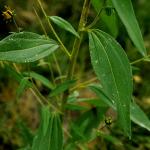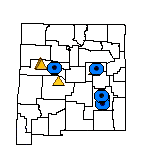Helianthus paradoxus (Puzzle Sunflower)
NONE
| USFWS | State of NM | USFS | BLM | Navajo Nation | State Rank | Global Rank | R-E-D Code | NMRPTC Status | Strategy Status |
|---|---|---|---|---|---|---|---|---|---|
| LT | E | S2 | G2 | 1-2-2 | R | SS |
| Overall Conservation Status | Documented Threats | Actions Needed |
|---|---|---|
| MODERATELY CONSERVED | Water management/use |
habitat protection, seed banking, trend monitoring |
Annual, 1-2 m tall, branched above, stem glabrous to hispid; leaves opposite below, alternate above, up to 17.5 cm long by 8.5 cm wide, lanceolate with 3 prominent veins, base tapering to a short petiole, margins entire except for a few prominent teeth on larger leaves, surface scabrous; flower heads solitary, terminating branches, 3-5 cm across including ray flowers; ray flowers 12-20, yellow; phyllaries 15-25, 3-4 mm wide, oblong-lanceolate, acuminate, hispid, margins ciliate; pales glabrous at tips; achenes 3-4 mm long, glabrous. Flowers August to October.
Helianthus paradoxus is intermediate between H. annuus and H. petiolaris. It differs from H. annuus in having narrower leaves, fewer hairs on the stems and leaves, smaller flower heads, narrower less abruptly acuminate phyllaries, and later flowering. It differs from H. petiolaris in having shorter petioles and no hairs at the tips of the pales of the flower head.
New Mexico, Cibola, Valencia, Socorro, Guadalupe, and Chaves counties; Texas, Pecos and Reeves counties.
Saturated saline soils of desert wetlands. Usually associated with desert springs (ciénegas) or the wetlands created from modifying desert springs; 1,000-2,000 m (3,300-6,600 ft). Helianthus paradoxus is a true wetland species that requires saturated soils; adult plants still grow well when inundated.
Helianthus paradoxus is a species of hybrid origin with the parents being H. annuus and probably H. petiolaris (Rieseberg et al. 1990). It is intermediate between its parents in morphology, but not in habitat preference likely indicating a long period of independent evolution after its origin. Helianthus paradoxus hybridizes with H. annuus; the offspring, which have low fertility, could backcross to H. paradoxus.
This species grows only in wetland habitats. Some activities that degrade or destroy wetlands include erosion leading to stream entrenchment, groundwater depletion, water diversions, filling, and invasion of exotic woody species, including Russian olives and tamarisk. Livestock will eat H. paradoxus (especially the flower heads) when other green forage is scarce. Disturbance may facilitate hybridization.
*New Mexico Native Plants Protection Advisory Committee. 1984. A handbook of rare and endemic plants of New Mexico. University of New Mexico Press, Albuquerque.
*Heiser, C.B., D.M. Smith, S.B. Clevenger and W.C. Martin. 1969. The North American sunflowers (Helianthus). Memoirs of the Torrey Botanical Club 22(3):1-220.
*Heiser, C.B. 1958. Three new annual sunflowers (Helianthus) from the southwestern United States. Rhodora 60:272-283.
Rieseberg, L.H., R. Carter and S. Zona. 1990. Molecular tests of the hypothesized hybrid origin of two diploid Helianthus species (Asteraceae). Evolution 44(6):1498-1511.
Roth, D. 2020. Pecos sunflower (Helianthus paradoxus) 2013-2020 monitoring report, Blue Hole Cienega Nature Preserve, Santa Rosa, New Mexico. Unpublished report prepared by the EMNRD-Forestry Division for the USFWS, Region 2. http://www.emnrd.state.nm.us/SFD/ForestMgt/endangeredandrareplantreports.html
For distribution maps and more information, visit Natural Heritage New Mexico










